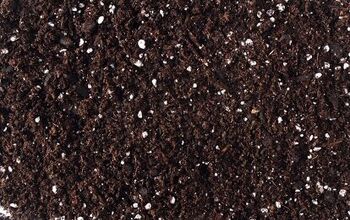How To Fill Holes In The Yard From A Dog

Man’s best friend loves to play outside and one of their favorite pass-times can spell disaster for your yard: Digging holes. These can be unsightly, dangerous, and bad for your soil.
Fill the hole with topsoil, cut a square of sod, and lay the sod over the topsoil in the hole. Water the hole each day for 1-2 weeks with up to 1 ½” of water. Put up plastic poultry fencing to keep the dog away from the area.
If that doesn’t ease your concern, don’t panic. We’re going to break down each step until you’re a master of your yard.
Do You Need Landscaping Services?
Get free, zero-commitment quotes from pro landscaper near you.

What You’ll Need
Before we get started, let’s go over any tools or supplies that you’ll need.
- Topsoil.
- A ruler.
- A shovel, trowel, block of wood, or something that can be used to pat the soil down.
- Gloves are optional.
Step 1: Clear the Hole
The first thing to do is to clear any debris, rocks, or weeds out of the hole. These can cause the soil to erode over time.
If the hole has been there long enough for the weeds to be overgrown, you may consider spraying the area with herbicide a week prior to filling the hole. Be sure that the herbicide is glyphosate-free and safe for pets. Most will have the term “organic” or “natural” in their name.
Step 2: Trim the Area
The next step is to mow or trim the surrounding area. Using a ruler, measure out a square to cut around the hole. To find the square footage for later, simply measure two sides of the square and multiply. Example: If the square is 2×2, it’s 4 square feet. 2×3 makes it 6, and so on.
Make sure you know what type of grass your yard is before mowing too low. Most grasses should be trimmed to 2-3 inches, depending on the type and season.
Step 3: Fill it!
Now comes the fun part: Fill the hole with topsoil. Topsoil can be found at most gardening supply stores, such as Lowes or Home Depot, starting around $25 per .75 cubic foot.
Add topsoil into the hole until it’s less than an inch from the surface, or as close to level as possible. It’s okay to leave a little room, because you can always add more.
Once the hole is filled, use a trowel or other object to pack down the soil. It’s important to be firm, but not hard. If you accidentally packed the soil down too much, don’t worry. Use a rod or something long to poke through and loosen the soil.
Step 4: Cut a Sod Square
Remember when you measured the area around the hole and mowed? This is where that comes in handy.
You can find a square of sod at most gardening stores, like the ones you’d find the herbicide in. Simply cut the square down to the desired measurements with scissors or shears. Only purchase fresh sod, or within 24 hours of it having been cut. If you use multiple squares, make sure the seams line up and lay them tightly together.
Step 5: Lay it down!
This is the easiest step, because you just lay the square of sod over the filled hole. If you measured right, it should fit perfectly. If not, you can always adjust. Be sure to water the soil before laying the sod down, as this will give the best adherence to the soil.
Once laid down, press gently on the sod to remove any air pockets underneath it. You want the sod in direct contact with the soil as much as possible.
If the sod sinks into the hole at all, you have 2 options: Add more topsoil to the hole, or mix equal parts soil and compost to top it off. The compost mix would give the soil more nutrients, but it also involves getting your hands dirty. Either way, once down, the sod will reseed the hole and make the surrounding area healthy as it grows back.
The alternative is to re-seed the soil yourself. To do this, buy grass seed and compact it into the topsoil either by hand or with a sod roller.
Once you fill the hole with the seed-filled topsoil, pack it down and spread compost or a seed accelerator on top. This usually ranges from $20-$30.
Step 6: Water the Area
With the hole being seeded, whether by the living sod or the mixed soil, the important part is to remember to water it once a day for 1-2 weeks.
Make sure to give enough water to wet the soil 6-8 inches. This means around 1 to 1.5 inches of water, depending on how deep the hole is.
During this time, you’ll also need to find a way to keep the dog away while the soil grows. A safe alternative to chicken wire is plastic poultry fencing. Whatever method you choose, though, the important thing is to protect the area until the soil is allowed to grow.
Sod or Seeds?
In step 5, I mentioned an alternative to the living sod, so you may wonder which one is better. The answer is up to you, but let’s look at the pros and cons.
Seeding is cheaper and has more options for your ideal lawn type.
The negatives are that you run the risk of over-seeding, which will thin your grass, and seeds take longer to grow. You can also only successfully plant seeds in short windows of time, somewhere between late spring and late summer depending on where you live. Rainfall and animals can also destroy your seeded area.
You can protect the seeds until they germinate, of course, but you have to keep the area safe and moist until they do.
Sod, on the other hand, leaves no exposed seeds that need protection and establishes quicker into the soil. It can be laid at any time during the growing season. Unfortunately, sod is more expensive and needs more water at the onset. It also provides fewer options for turf.
Get to the Root of the Issue
Ignoring the terrible pun, you may consider finding a way to prevent having to revisit this situation. Here are a few suggestions to get your dog to stop digging:
- Spray the yard with bad smells, like citrus or coffee grounds.
- Fill a plastic pool with dirt to centralize where your dog digs.
- Exercise your dog.
- Train your dog not to dig holes, whether alone or with a dog trainer.
These are just a few options, but the important thing is to identify why your dog is digging the holes and go from there.
Do You Need Landscaping Services?
Get free, zero-commitment quotes from pro landscaper near you.

Related Questions
How do I stop my dog from digging under the fence?
If your dog is digging holes in the yard, there’s a good chance that some of those occur near the fence. If that’s the case, you can install chicken wire or pile up stones to stop it from happening.
How do I stop my dog from scratching on the door?
Another bad habit that our furry friends can have is to scratch on the door, whether it’s because they miss us, need to get out, or some other reason. This issue is entirely fixable.
Related Guide

We are a team of passionate homeowners, home improvement pros, and DIY enthusiasts who enjoy sharing home improvement, housekeeping, decorating, and more with other homeowners! Whether you're looking for a step-by-step guide on fixing an appliance or the cost of installing a fence, we've here to help.
More by Upgraded Home Team



























